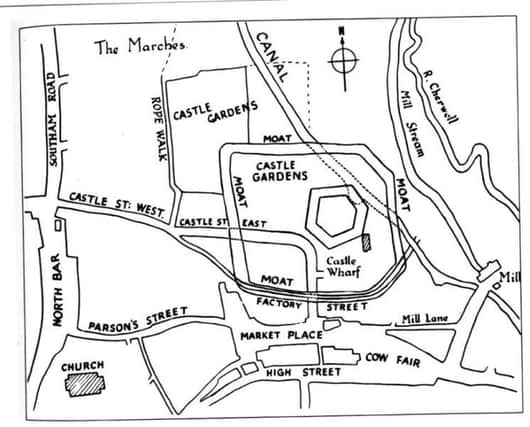Look back with Little: Castle rollercoaster


This concerned redevelopment of a blighted and back land area based on Factory Street and the Castle Streets.
Up until the 1950s this had been a much-loved residential fringe of the town centre and the subject of delightfully recorded memories for the period 1922-1939 penned by Cicely Bailey, a member of my first local history class, and the same period but finishing at the end of World War II by Annie Meadows, a teacher at Dashwood Road School.
Advertisement
Hide AdAdvertisement
Hide AdThe original castle was built at the behest of the Bishop of Lincoln, Alexander of Blois (1123-48).
Its defensive merits made possible the creation of a market place, which in turn was the nucleus of a 12th century new town.
Other castles followed in the later 13th/early 14th century and during substantial repairs prior to the events leading to the sieges of 1644 and 1646.
It is unfortunate that two 17th century sieges of Banbury Castle and its subsequent demolition after a petition by Banbury inhabitants for the use of its materials to repair the town left us with little idea of what the castle looked like.
Advertisement
Hide AdAdvertisement
Hide AdThe archaeological achievements by Peter Fasham (early 1970s) and Steve Litherland (1990s) produced finds for Banbury museum where an exhibition was mounted.
The work by Steve’s Birmingham University team included many triumphs notably in September 1997 when they revealed a section of the inner moat, which had been concealed by the pay and display Castle Gardens Car Park.
Claire Gould reported on this for the Banbury Guardian. She interviewed Edward Newton, technical support officer for the Birmingham team and noted that the discovery was the result of a ground radar survey.
This along with the application of other techniques was funded by the developers Raglan PLC, Banbury Shopping Centre Ltd and Pillar Caise.
Advertisement
Hide AdAdvertisement
Hide AdMr Newton added that excavation had had to be limited to 3.5 metres as this was the level of the water table.
However it was hoped to go deeper elsewhere within the car park as the best artefacts were expected to be at a greater depth.
He did not rule out the prospect of a discovery worthy of preservation on site.
Such a move would have been a valuable facet of the shopping centre development, which in its publicity highlighted the past significance of wharf areas by using the image of the Oxford Canal’s wharfside in contest.
Advertisement
Hide AdAdvertisement
Hide AdSubsequent owners of this comprehensive development area have also been unable to include a permanent link with the castle site.
This is a matter of regret as we know that origins of Banbury lie in the mediaeval period. This was when the town was starting to assume an urban character.
A less well-known outcome of the archaeological exploration of Banbury’s historic core was an examination of the results with reference to their wider significance.
First and foremost the excavations had covered a larger geographical area of the town than previously studied and in 1974 field officer Kirsty Rodwell was able to report the unexpected discovery of a small store building from the 13th century or earlier making it one of the oldest buildings found in Banbury.
Advertisement
Hide AdAdvertisement
Hide AdBack in 1969 there had been published models based on documentary and cartographic analysis (the Lobel study).
The Litherland team had found evidence that could be put side by side with earlier results. Especially important were pointers to the nature of the town in late Saxon and early Norman times.
It was also thought possible to reassess industrial development from the late 1700s.
From a regional point of view the Birmingham team’s work had implications for the examination of market centre development whilst also shedding light on castles in general.
Advertisement
Hide AdAdvertisement
Hide AdSharp eyed visitors to Castle Quay’s mall will have noticed proposal plans for a phase two development which will envelop the canal.
It is likely that an important outcome of this will be the creation of a cultural quarter, to date an unfulfilled dream.